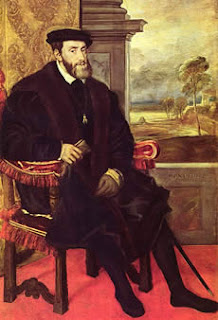 |
| Charles V (Charles I of Spain) |
In addition, the Habsburgs had held the elected position of the Holy Roman Emperor (a collection of lands that included today’s Germany, Austria, the Czech Republic, northern Italy, Switzerland, the central eastern part of France, and the Low Countries).
Although the constituent lands of the Holy Roman Empire (mostly Germany and adjacent lands) were basically independent, the title held great prestige as it implied a primacy in Western Christendom. The fall of Constantinople in 1453 placed the Western Empire in a position of primacy in Europe.
Charles’s inheritance from his paternal grandmother was also impressive. The House of Burgundy, although an offshoot of France, had amassed a whole series of lands that included the Netherlands and adjacent areas, such as the County of Burgundy (Franche-Comte) and Luxembourg.
At that time, the Netherlands not only included the present-day countries of Holland and Belgium, but also much of northern France and parts of northern Germany. In many ways, it was the wealthiest country in Europe with textile products, crafts, commerce, and precapital financial processing, thereby making it a center of the European economy.
After the death of an older sister, Charles’s mother, Juana of Spain, became the heiress of the fabled Indies. From his grandmother, Isabella, Charles inherited the Crown of Castile, which comprised 60 percent of the Iberian Peninsula.
More importantly, it included the title to the Indies, which turned out to be western South America, most of the present West Indies, Central America, and present-day Mexico, including parts of the present-day Southwest United States.
From his maternal grandfather, he inherited the Crown of Aragon, about one-quarter of Iberia. Significantly, this included claim to Naples, Sicily, and Sardinia, together about 40 percent of modern-day Italy. Charles inherited these territories at an early age.
His father died in 1506, and soon thereafter, his mother was declared insane. His maternal grandfather and grandmother, Ferdinand V and Isabella I, passed away in 1515 and 1504, respectively, while his paternal grandfather, Maximilian, passed away in January 1519.
Far-Flung Government
With these vast inheritances came vast responsibilities. All of Charles’s land possessions had separate governments that warranted consideration. Castile had separate governments not only in Granada, which had recently been conquered, but also overseas.
 |
| Charles V on horse back |
The Netherlands had 18 separate jurisdictions in addition to Franche-Comte, as did the landgravate of Alsace and the Austrian possessions. While all of these could at least contribute to the exchequer, the Holy Roman Emperor was a title without much power.
Germany also at this time was composed of 300 separate states. To complicate matters further, Charles faced the menace of the Turks under their greatest ruler, Suleiman I the Magnificent, who were advancing into the Balkans.
He forced the Turks back after they invaded Austria in 1531, but much of the Balkans remained under Turkish control. Charles captured Tunis in 1535 and helped drive the Turks out of northern Africa temporarily.
Among Charles’s greatest challenges was France and its monarchs, the Valois. The French, especially under Francis I (1515–47), resented his position in Europe and feared encirclement by Charles and his family, the Habsburgs. The French sought to regain French-speaking sections of the Netherlands and wanted to gain power in Italy with claims to both Milan and Naples.
The result was a series of wars between 1521 and 1559 between the French and Charles and his son, Philip II of Spain. In the end, the Spaniards remained supreme in Italy with Lombardy under their control, in addition to Naples, Sicily, and Sardinia.
The Protestant Reformation, which broke out in the German territory between 1517 and 1521, was another of Charles’s major challenges. The Reformation split Germany and prevented unity against the Turks and the French.
After earlier successes, opposition that appeared in 1552 forced Charles to retreat as some of his allies—both Catholic and Protestant—felt he was too powerful. The resulting Peace of Augsburg froze existing section lines in place between Catholics and Protestants.
In broad terms, Charles’s job was to preserve his inheritance. He tried to maintain his inheritance via marriage alliances and aiding his royal family, although he was not always successful. He tried to gain peace with France through the marriage of his widowed sister Eleanor to Francis I.
On the other hand, he could not help his brother-in-law, Christian II of Denmark, who was deposed. And although he supported his aunt, Catherine, whose husband, Henry VIII, divorced her, he could not stop the divorce.
More successfully, after his sister’s husband, Louis of Hungary, perished at Mohácz in 1526, he arranged a marriage of his brother Ferdinand to Anne of Hungary, which led to the annexation of Czech territories and that part of Hungary not conquered by the Turks. His own marriage to Isabella of Portugal led to the annexation of that country in 1580 when the last male heir of the royal house of Portugal died.
Ultimately Charles realized that his empire, lacking real cultural or administrative unity, could not be sustained. Realizing that his health was failing (he had gout and dropsy), he handed over his Spanish, Italian, and Netherlands possessions to his son, Philip II, in October 1556, and his Austrian lands and Holy Roman Emperor title to his brother Ferdinand I. He died two years later. Although not a brilliant ruler, Charles accomplished his goal of maintaining his empire so as to pass it on to his heirs.
EmoticonEmoticon